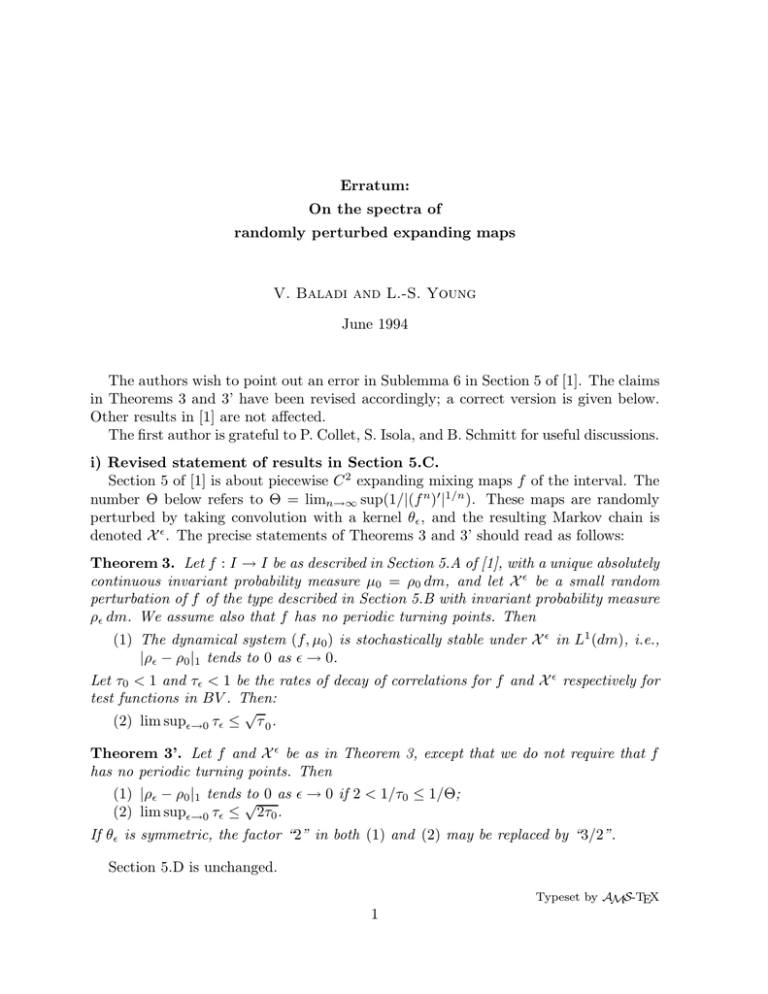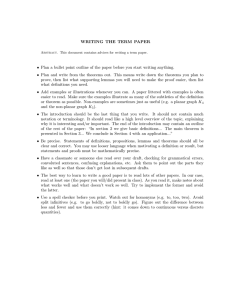Erratum: On the spectra of randomly perturbed expanding maps
advertisement

Erratum:
On the spectra of
randomly perturbed expanding maps
V. Baladi and L.-S. Young
June 1994
The authors wish to point out an error in Sublemma 6 in Section 5 of [1]. The claims
in Theorems 3 and 3’ have been revised accordingly; a correct version is given below.
Other results in [1] are not affected.
The first author is grateful to P. Collet, S. Isola, and B. Schmitt for useful discussions.
i) Revised statement of results in Section 5.C.
Section 5 of [1] is about piecewise C 2 expanding mixing maps f of the interval. The
number Θ below refers to Θ = limn→∞ sup(1/|(f n)′ |1/n ). These maps are randomly
perturbed by taking convolution with a kernel θǫ , and the resulting Markov chain is
denoted X ǫ . The precise statements of Theorems 3 and 3’ should read as follows:
Theorem 3. Let f : I → I be as described in Section 5.A of [1], with a unique absolutely
continuous invariant probability measure µ0 = ρ0 dm, and let X ǫ be a small random
perturbation of f of the type described in Section 5.B with invariant probability measure
ρǫ dm. We assume also that f has no periodic turning points. Then
(1) The dynamical system (f, µ0 ) is stochastically stable under X ǫ in L1 (dm), i.e.,
|ρǫ − ρ0 |1 tends to 0 as ǫ → 0.
Let τ0 < 1 and τǫ < 1 be the rates of decay of correlations for f and X ǫ respectively for
test functions in BV . Then:
√
(2) lim supǫ→0 τǫ ≤ τ 0 .
Theorem 3’. Let f and X ǫ be as in Theorem 3, except that we do not require that f
has no periodic turning points. Then
(1) |ρǫ − ρ0 |1 tends √
to 0 as ǫ → 0 if 2 < 1/τ0 ≤ 1/Θ;
(2) lim supǫ→0 τǫ ≤ 2τ0 .
If θǫ is symmetric, the factor “2” in both (1) and (2) may be replaced by “3/2”.
Section 5.D is unchanged.
Typeset by AMS-TEX
1
ii) Revised version of Section 5.E.
We follow the notation introduced at the beginning of 5.E, except that we consider
only the situation where
Σ0 = {1} and Σ1,0 = ∅ .
That is to say, the reader should read 5.E with κ0 = 1, κ11 = κ1 = τ0 , etc.
Sublemma
R 6, which is problematic in [1], is valid in this more limited setting because
π0 ϕ = ρ0 · ϕ dm. Lemmas 1’ and 3’, which use Sublemma 6, are also correct under
the present assumptions. We take this opportunity to add “X0ǫ → X0 ”, which had been
inadvertently left out in [1], to the conclusion of Lemma 3’.
To prove Theorem 3, one applies Lemmas 9, 1’ and 3’ p
with κ close
p to (and slightly
√
bigger than) τ 0 . To prove Theorem 3’, take κ close to τ0 /2 (or τ0 /(3/2) if θǫ is
symmetric).
References
1. V. Baladi and L.-S. Young, On the spectra of randomly perturbed expanding maps, Comm. Math.
Phys. 156 (1993), 355-385.
Mathematik, ETH Z ürich, CH 8092 Z ürich, Switzerland
(on leave from UMPA, ENS Lyon (CNRS, UMR 128), France)
E-mail address: baladi@math.ethz.ch
Department of Mathematics, UCLA, Los Angeles, CA 90024, USA
E-mail address: lsy@math.ucla.edu
2



